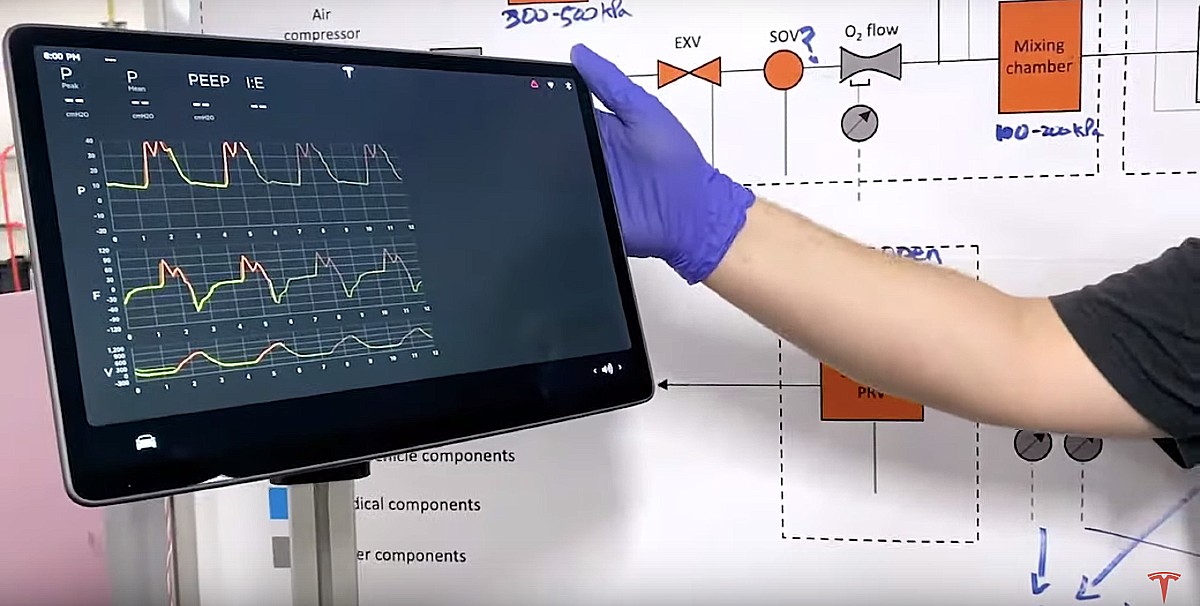An Anaesthetics and Intensive Care Unit (ICU) nurse recently broke down Tesla’s video of its in-house ventilator system that is made from Model 3 parts.
YouTuber Chris Vanderstock is a nurse by trade and holds over 20 years of experience in a medical setting. His resume includes years of administering patients with real-life medical conditions anesthesia before surgeries and providing them with air via the operation of a manual resuscitator. Vanderstock has plenty of experience with critical care ventilators and how they operate making him a prime candidate to give Tesla’s engineering team relevant feedback toward its newly designed machine.
Vanderstock was initially impressed with Tesla’s utilization of its vehicle parts to create an efficient ventilator. “I reckon a good two-thirds of this ventilator is from existing parts that Tesla already has,” the veteran nurse said. After listing the parts that will be included in the ventilator, like the Model 3’s display, Vanderstock gave his kudos to the Tesla team. Tesla’s goal was to use primarily parts that it knew for reliability purposes, as well as not take away any parts from the medical community who are already struggling with providing hospitals with ventilators, to begin with.
The mixing chamber that is responsible for combining several gases to create breathable air for a patient who is having trouble breathing is a critical part of a ventilator. Along with the mixing chamber, several pressure monitors, along with volume sensors that will provide the patient with the correct levels of oxygen, are included in the Tesla ventilator. Vanderstock noted that this is one of the most crucial parts of a ventilator, as too much air into the lungs can overinflate them, causing more damage than there was initially. Tesla nailed this, according to Vanderstock. “Kudos to these guys.”

Perhaps one of the most exciting portions of the Tesla-made ventilator is the use of two filters, one on the patient end where air is distributed to a patient’s lungs, and one on the machine end, where the virus will be displaced as the patient exhales. This double-filter feature is a notable part of ventilators from Medtronic, a company that Tesla has been in talks with since late March. Vanderstock says the ventilator’s machine-end filter is crucial to keeping healthcare workers safe, as a non-filtered machine end could lead to the virus being spread to those in the room.
The only concern Vanderstock had about the ventilator was how Tesla planned to warm and humidify the oxygen that will go to a patient’s lungs. “When you are thinking about how we breathe, our nose, the turbinates, the structures behind your mouth, going down your trachea into your lungs, are all being warmed…by your blood supply. As air travels down, it gets warmed on the way, and obviously, you’ve got the mucosal layers that’s sending in a bit of moisture as well,” he remarked.
One of Vanderstock’s favorite features is the inclusion of the Model 3 dash screen that will display information like pressure and oxygen concentration to medical professionals. “The innovative infotainment system could potentially help patients. Very good job at Tesla, well done,” he said.
All in all, Vanderstock is exceptionally impressed with Tesla’s ability to create a ventilator that has such an effective manner in a short amount of time. “Nonetheless, great first effort,” he said.
While the machine will still have to pass through Food and Drug Administration (FDA) regulations, he believes this process could be expedited as ventilators are needed on the front lines of hospitals in some of the United States’ most prominent cities.
CEO Elon Musk has stated that ventilators, whether they are purchased or manufactured by Tesla, will be available for free with worldwide shipping as long as the hospital requesting the machines is in immediate need of them. Musk has already made over 1,200 donations to Los Angeles and New York City hospitals as the COVID-19 pandemic is expected to reach its peak this week, according to U.S. Surgeon General Jerome Adams.
Watch Chris Vanderstock’s breakdown of the Tesla Ventilator below.
[embedded content]

<!–
–>
